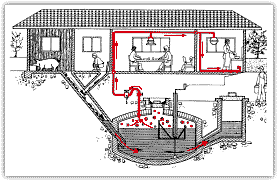|
| ||
| Energy from organic waste The utility of biological sources | ||
| by Alessandro Gatto | ||
| Among the so-called “alternative energies” there is also that which can be obtained from biological sources such as organic waste. It nevertheless has to be remembered that, producing energy from the biomass implies integration within the biological cycle; in order to avoid upsetting the delicate balance of living systems one has to be competent in the fields of biology, mechanics and engineering, and act with interdisciplinary awareness and extreme caution.
Bioconversion can be effected on vegetables and vegetable waste, as occurs in Brazil for the production of alcohol for automotive fuel, but also on recuperated waste products such as sawdust, straw and refuse. At present the energy production is only certain in small plants which can produce biogas through methanogen fermentation, and plants which can produce ethyl alcohol through alcoholic fermentation. Nevertheless there is also the possibility of producing gas and vegetable carbon through pyrolysis. | ||
|

